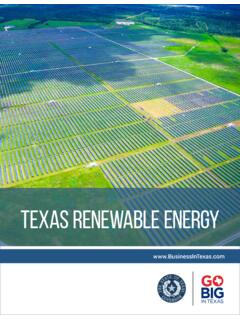Transcription of SMART METER ROLL- OUT COST-BENEFIT ANALYSIS
1 SMART METER ROLL- OUT COST-BENEFIT . ANALYSIS . Part I. August 2016. Note on structure This is the first part of a two part publication. Part I provides a summary of the changes to evidence and methodology since the 2014 Impact Assessment (IA), and the effect these changes have on the costs and benefits of the SMART METER ROLL- out. Part II provides more detail in a technical annex of the evidence base on which the assessment is now based for both the domestic and non-domestic sector. It also includes information on monitoring and evaluation, and specific impact tests. 1. Title: 1. SMART METER ROLL- out for the domestic and small and medium Updated COST-BENEFIT ANALYSIS (CBA). non-domestic sectors (GB). Stage: Final (updated). Source of intervention: Domestic Lead department or agency: BEIS Type of measure: Secondary legislation Contact for enquiries: Other departments or agencies: Cost of Preferred (or more likely) Option Total Net Present Business Net Net cost to In scope of One- Measure qualifies Value Present Value business per year In, One-Out?
2 As 2. 5,746m 724m As per 2014 IA Yes In What is the problem under consideration? Why is government intervention necessary? Lack of accurate, timely information on energy use: a) may prevent customers from reducing consumption and therefore bills and CO2 emissions and; b) increases suppliers' accounts management and switching costs. Better information on patterns of use across networks will aid network planning and development, including future SMART energy systems. In Great Britain (GB), the provision of energy meters to consumers is the responsibility of energy retail suppliers, who would be unlikely to deploy SMART meters in a way that delivered early benefits or increased competition in the absence of government intervention. What are the policy objectives and the intended effects? To ROLL- out SMART metering to GB residential and small and medium sized non-domestic gas and electricity customers in a cost-effective way, optimising the benefits to consumers, energy suppliers, network operators and other energy market participants and delivering environmental and other policy goals.
3 What policy options have been considered, including any alternatives to regulation? Please justify preferred option (further details in Evidence Base). This policy focuses on the mandated replacement of approximately 53 million residential and non-domestic gas and electricity meters in GB through a supplier-led ROLL- out with a centralised data and communications company providing interoperability. The March 2011 IA set out Government's overall approach and timeline for achieving this objective. Subsequent updates in 2013 and 2014 reflected the most recent evidence base following the introduction of the first tranches of SMART metering regulations. This update reflects developments in the delivery of the ROLL- out since 2014 and new evidence that has come to light, including data from early SMART METER deployment. Will the policy be reviewed? It will be reviewed If applicable, set review date: After completion of the ROLL- out Does implementation go beyond minimum EU requirements?
4 Yes Are any of these organisations in scope? If Micros Micro < 20 Small Medium Large not exempted set out reason in Evidence Base. Yes Yes Yes Yes Yes What is the CO2 equivalent change in greenhouse gas emissions? Traded: Non-traded: (Million tonnes CO2 equivalent) I have read the updated COST-BENEFIT ANALYSIS and I am satisfied that, given the available evidence, it represents a reasonable view of the likely costs, benefits and impact of the leading options. 1. Although this COST-BENEFIT ANALYSIS is not an IA, it has been presented in the IA template to enable comparison with previous assessments published by DECC on the SMART METER ROLL- out. 2. This assessment reflects an update of the SMART METER evidence base rather than a change to existing policy. As such metrics relevant for the OIOO accounting system as reflected in the 2014 IA remain unchanged. 2. Summary: ANALYSIS & Evidence Policy Option 1.
5 Description: This assessment reflects a supplier led ROLL- out of SMART meters with a centralised Data and Communications Company (DCC). FULL ECONOMIC ASSESSMENT. Price Base Year PV Base Time Period Net Benefit (Present Value (PV)) ( m). 2011 Year 2016 Years 18 Low: 1,260 High: 10,589 Best Estimate: 5,746. COSTS ( m) Total Transition Average Annual Total Cost (Constant Price) Years (excl. Transition) (Constant (Present Value). Low NA Price). NA NA. High NA NA NA. Best Estimate 717 721 A/A. 10,981. Description and scale of key monetised costs by main affected groups'. Meters, their installation and operation, and the In-Home Displays (IHDs) amount to DCC related costs, including communications hubs provision, amount to Energy suppliers' and other industry's IT. systems costs amount to Industry governance, organisational and administration costs, energy, pavement reading inefficiency and other costs amount to Other key non-monetised costs by main affected groups'.
6 NA. BENEFITS ( m) Total Transition Average Annual Total Benefit (Constant Price) Years (excl. Transition) (Constant (Present Value). Low 0 Price). 898 12,218. High 0 1,589 21,593. Best Estimate 0 1,230 16,726. Description and scale of key monetised benefits by main affected groups'. Total consumer benefits amount to and include savings from reduced energy consumption ( ), and avoided costs of microgeneration metering ( 57m). Total supplier benefits amount to , composed of avoided site visits ( ), and reduced inquiries and customer overheads ( ). Total network-related benefits amount to 839m and generation benefits to 943m. Carbon related benefits amount to Air quality improvements amount to 98m. Other key non-monetised benefits by main affected groups'. These include benefits from further development of the energy services market and the potential benefits from the development of smarter energy systems.
7 SMART metering is expected to result in stronger competition between energy suppliers due to increased ease of consumer switching and improved information on consumption and tariffs. An end to estimated billing and more convenient switching between credit and pre- payment arrangements will improve the customer experience. Key assumptions/sensitivities/risks Discount rate assumptions are adjusted for risk optimism bias where appropriate, and benefits are presented for the Cost central scenario unless stated otherwise. Sensitivity ANALYSIS has been applied to the benefits as energy savings depend on consumers' behavioural response to information which could affect the benefits substantially. The numbers presented are based on the modelling assumption that the scope of the DCC will include data aggregation in the long term. 3. Annual profile of monetised costs and benefits (undiscounted)*.
8 M 2013 2014 2015 2016 2017 2018. Total annual costs 121 110 267 444 594 881. Total annual benefits 55 67 97 163 342 723. m 2019 2020 2021 2022 2023 2024. Total annual costs 1,120 1,153 1,022 987 983 950. Total annual benefits 1,162 1,430 1,539 1,675 1,699 1,769. m 2025 2026 2027 2028 2029 2030. Total annual costs 950 950 951 757 721 740. Total annual benefits 1,839 1,886 1,899 1,897 1,931 1,971. * For non-monetised benefits please see summary pages and main evidence base section Emission savings by carbon budget period (MtCO2e). Sector Emission Changes* (MtCO2e) - By Budget Period CB II; 2013-2017 CB III; 2018-2022 CB IV; 2023-2027. Traded 0 0 0. Power sector Non-traded 0 0 0. Traded 0 0 0. Transport Non-traded 0 0 0. Workplaces & Traded Industry Non-traded Traded Homes Non-traded Traded 0 0 0. Waste Non-traded 0 0 0. Traded 0 0 0. Agriculture Non-traded 0 0 0. Traded 0 0 0. Public Non-traded 0 0 0.
9 Total Traded Non-traded % of lifetime emissions below 100%. traded cost Cost comparator effectiveness % of lifetime emissions below 100%. non-traded cost comparator 4. Table of contents Glossary of Terms .. 6. Section A: Introduction and New 7. 1 Introduction .. 7. Background and Strategic Overview .. 7. Rationale for Government intervention .. 8. Policy objectives .. 10. The Economic Case for SMART Metering .. 10. 11. Costs .. 12. Economic impact .. 13. Scope and structure of this assessment .. 13. 2 New ANALYSIS .. 14. Context .. 14. Overall change in net present value .. 14. Methodological updates .. 15. Present value base year .. 15. Changes to exogenous assumptions .. 16. Cost update for the DCC, its service providers and other mandated organisations 17. DCC and core service provider cost update .. 17. Other service provider cost updates .. 17. Cost update for SMART Energy 18.
10 Updated ROLL- out profiles and timing assumptions .. 18. Updated installation and equipment cost assumptions .. 21. Installation costs .. 21. METER asset costs .. 22. Financing costs for SMART METER assets and installation costs .. 22. Overall impact of changes to installation and asset cost assumptions .. 23. DCC adaptor service costs for smaller suppliers .. 23. Updated assumptions about Home Area Network solutions and costs .. 23. 868 MHz equipment .. 23. Point in time when the 868 MHz HAN solution is assumed to be available .. 24. Costs for the development of the alternative HAN 24. Aggregate impact of changes to HAN solution assumptions .. 25. Update of advanced METER volume and cost assumptions .. 25. Revision of network-related benefits .. 26. Non-quantified benefits to 27. Updated assumptions about IHD costs .. 28. Payment profile of IHD 28. Optimism bias applied to IHDs.

















